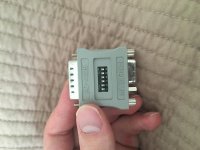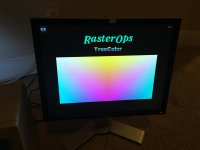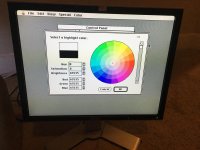While I have had this video card for exactly a week now, I finally got the VGA adaptor required to plug a VGA monitor into the DB15 connector! Now, I was a little worried about how my modern flat panel monitor would react to the video card's output, but it seems to like the signal just fine! Also, I hear that this card is capable of 24-bit color, but 256 colors is my highest option in the monitors control panel. I probably need to install RasterOps' software.
The adaptor that ties everything together:

Declaration ROM start up splash screen. I really like the color gradient!

And of course the System 6.0.8 boot floppy desktop. Color control panel is open, with color picker open. I like how the picture doesn't look stretched, or otherwise messed up. I also like how good of a job my monitor is doing at upscaling to 1600x1200 the input from the SE/30!

Side Note: If you want pictures of the card's PCB, consult my conquests thread titled "Macintosh SE/30"
The adaptor that ties everything together:

Declaration ROM start up splash screen. I really like the color gradient!

And of course the System 6.0.8 boot floppy desktop. Color control panel is open, with color picker open. I like how the picture doesn't look stretched, or otherwise messed up. I also like how good of a job my monitor is doing at upscaling to 1600x1200 the input from the SE/30!

Side Note: If you want pictures of the card's PCB, consult my conquests thread titled "Macintosh SE/30"
Last edited by a moderator:
